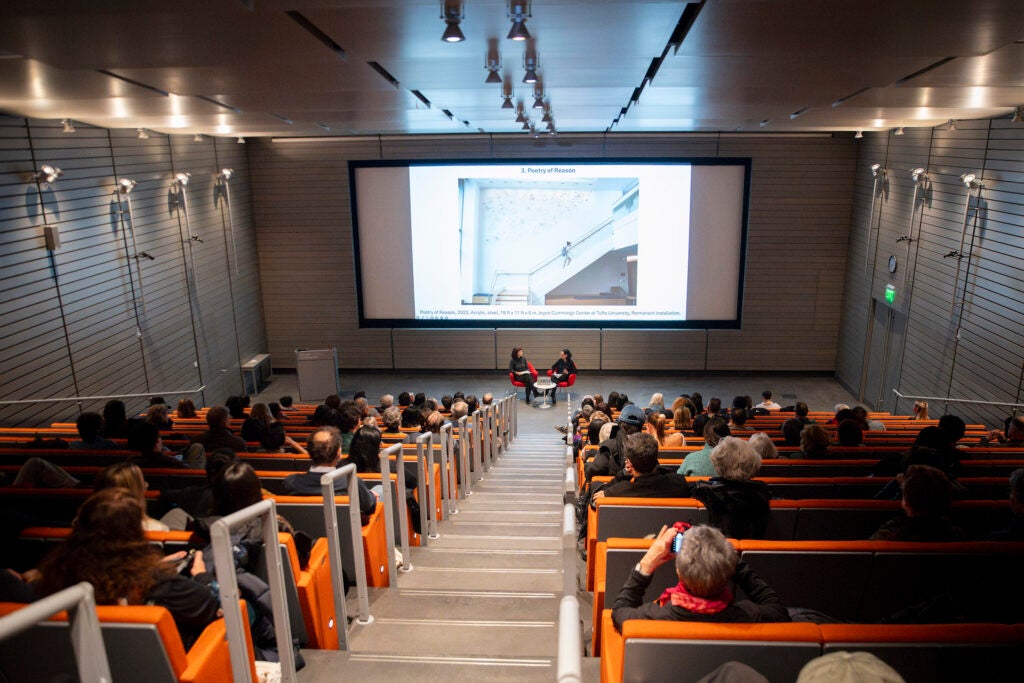‘It is your family’s journey, too’
Artist Yu-Wen Wu discusses ‘Walking to Taipei,’ a recent Museums acquisition, and how immigration, life experiences inspire her work

Photos by Niles Singer/Harvard Staff Photographer
Yu-Wen Wu was shocked to learn how much plane tickets to Taiwan cost when she wanted to visit her sick grandmother in 2010.
She started to brainstorm options. “I decided I could walk to Taipei,” the artist told a crowded room at the Harvard Art Museums on Feb. 21. “I typed it into the Google Maps and asked for walking instructions to Taipei from Boston. What it gave me was a set of instructions, 2,052 instructional steps.”
The product of that thought experiment? A 25-foot handscroll with Wu’s Google Maps directions cut and pasted in order, a route for a trek of 11,749 miles over an estimated 155 days and five hours, including a 52-day (and one hour) kayak voyage across the Pacific Ocean.


Wu joined Sarah Laursen, the Alan J. Dworsky Curator of Chinese Art, last month to discuss the Museums’ recent acquisition of “Walking to Taipei,” along with some other notable works by Wu.
“Walking to Taipei” is being displayed in segments rolled out every three weeks by museum staff. The artist says the piece explores her relationship to her heritage and the disconnection of assimilation.
“This work was a journey for me, an emotional journey of longing for home and my grandmother, who was very dear to me,” she said. “I felt as if it were a gift bestowed on me from cyberspace.”
Wu and her family’s immigration story began when her father moved to the U.S. from Taiwan after the passage of the Immigration and Nationality Act of 1965. Wu arrived years later at 7, along with her mother and brother.
“Walking to Taipei” was not an easy project.
“The final version of ‘Walking to Taipei’ took nearly 10 years to complete. I moved my studio twice during that time and often needed to put it aside to work on other projects,” she said.
Printed on two colors of mulberry paper and glued to semitransparent Dura-Lar film, Wu said the work plays on mixing tradition with modernity.
“It provides a beautiful juxtaposition,” she said.
Other work by Wu can be found on campus. “Terrain,” a 30-foot, laser-cut aluminum mural resembling a Song dynasty landscape painting is on permanent display at Harvard Business School. The work mixes Eastern style with Western motifs (one of the mountain ranges depicts 100 years of trends for the S&P 500.)
Down the road at Tufts, another commissioned work, “The Poetry of Reason” hangs in the Joyce Cummings Center. “The Poetry of Reason” is more than two stories high and comprised of about 30 disks that have “fundamental pieces of knowledge across disciplines,” a work that combines Wu’s artistic sensibilities with her background in science.
Wu, who studied the sciences as an undergraduate at Brown, first moved to Boston in 1981 to work as a research assistant in the lab of Nobel Prize-winning neurophysiologist David H. Hubel, studying the structure and function of the visual cortex.
“David Hubel was an amazing mentor because he really believed that scientists could benefit greatly from cultivating their artistic interests, which ultimately encouraged the multidisciplinary nature of my artistic practice,” Wu said.
She worked with Tufts’ computer science department to create “Poetry” and hopes it can continue to inspire discovery.
“I believe public artwork is strongest when it has the possibility of new iteration allowing it to stand as a living archive,” she said.
Yu-Wen Wu
“ I believe public artwork is strongest when it has the possibility of new iteration allowing it to stand as a living archive.”
Other work by Wu that plays on the idea of iteration includes “Lantern stories,” a project commissioned by the Rose Kennedy Greenway Conservancy in 2020. The work is made up of 31 lanterns illuminating Chinatown history that hung in Auntie Kay & Uncle Frank Chin Park on the Greenway near Chinatown in 2022.
“‘Lantern stories’ invites the viewer to learn more about the history of immigration — about the racial violence, exclusionary policies, and all the injustices throughout history and current times faced on multiple levels by the AAPI [Asian American Pacific Islander] community,” Wu said.
To develop the work, she held community listening sessions and received feedback on what images would be important to include on the lanterns. “Lantern stories” went on to have a run in San Francisco’s Chinatown, where local artists added their own stories to additional pieces.
Wu’s work sharing stories of immigration also extends to her evolving “Leavings/belongings.” Working with refugee organizations in Worcester, Massachusetts, Minneapolis, and Santa Fe and Albuquerque, New Mexico, the installation includes fabric bundles created by immigrants to represent their journeys. Different iterations, including one at Boston’s Pao Arts Center where a video shares the stories of the refugees, have been displayed across the country.
“Walking to Taipei” is on view in an installation titled “Journeys” in Harvard Art Museums Gallery 2600 Level 2. It will be on display through June 2.
“I think every artist hopes that the artwork they create will extend beyond their personal experience,” Wu said of her work. “My journey as an immigrant is a narrative about my own story [but] it also extends beyond, to your story. It is your family’s journey, too.”




